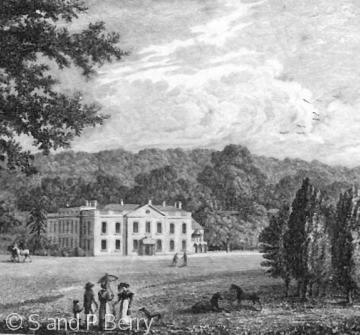Country Houses in the City of Brighton and Hove

The City of Brighton and Hove has spread over a dozen ‘ancient’ parishes on the South Downs (Aldrington, Brighton, Falmer, Hangleton, Hove, Ovingdean, Patcham, Portslade, Preston, Rottingdean, Stanmer and West Blatchington). During the early 1500s, the village of Brighton began to expand and became a town, which by the early-mid 1600s numbered around 3,500, more residents than Lewes or Chichester. This was thanks to long distance fishing. The town’s residents packed into a tiny area beside the sea close to their net shops and capstans, which stood below the town’s low and crumbly cliff front. The surrounding parishes were entirely rural. They produced wheat and barley as cash crops and ran large flocks of sheep. This type of agriculture was most efficient on large farms some of which became the core of down land estates. Thus, the population of many of the villages and hamlets declined due to lack of work.
Meanwhile, between about 1530 and 1700 the South Downs was dotted with new country houses. Several are now within the bounds of the City. By the 1500s, the Downs were popular for hunting and, as a means of travel between the east and west ends of Sussex. By 1700, country houses stood every few miles along them. The number of houses declined from the 1760s, when the larger estates began to expand by acquiring smaller ones or buying those with owners in debt. Then surplus country houses were either demolished or became farmhouses.
Before 1500 the only ‘country’ house used in this area by gentry was Benfield, a large hunting lodge used by the wealthy Covert family with estates in Slaugham to the north in the Sussex Weald (see picture). The Bellingham family built Hangleton Place (now a pub) in the mid 1500s in a courtyard style. They sold to the Earl of Dorset in the 1590s. It ceased to be a country house although for a while a wing was reserved for the use of the owners as they travelled to Halnaker House in West Sussex.
Richard Shelley, a son of the owner of Michelgrove (a massive house that stood on the Downs in the parish of Clapham, West Sussex) bought land in Patcham. He probably built Patcham Place before 1552. Anthony Stapley (who signed the death warrant for Charles Ist) then bought the Patcham estate. The substantial older house is hidden behind a facade of black mathematical tiles. They disguise the extension of the older house between the 1760s and 1780 by the Paine family.
The Shirley family demolished the ancient house at Preston and built Preston Place in stone and timber in the 1590s. The Western family turned the house ninety degrees to face north south in the 1730s and in the 1760s added wings which can be seen most clearly now from the north side.
Henry Pelham, one of the influential Pelhams of East Sussex whose best known relative was Thomas Pelham-Holes, the Duke of Newcastle commissioned Nicholas Dubois to design the austere 1720s Stanmer Place in sandstone from Lindfield and demolished the extensive living quarters of the old house. The building accounts, which include the partial demolition of the older building survive. The work was completed by his brother who was nicknamed ‘Turkey’ Pelham because that is where he was sent to earn his keep by his father by trading.
By 1783, Nathaniel Kemp (the uncle of Thomas Read Kemp of Kemp Town) owned land in Ovingdean. Ovingdean Place built by him in 1792-3, the estimate for the work and some of the fitting out was 2653..10shillings. The facade is cream mathematical tiles. Meanwhile, Nathaniel and his first wife rented Preston Place which was sold by the Western family to William Stanford.
Today the only house we have lost is Benfield. The rest survive, though Preston Place (now Preston Manor) was greatly altered and the service wing for Stanmer has been demolished. Hangleton Place is now the Hangleton Manor pub and much smaller than it was in the reign of Elizabeth Ist.
Content derived from research undertaken as part of the Victoria County History project



